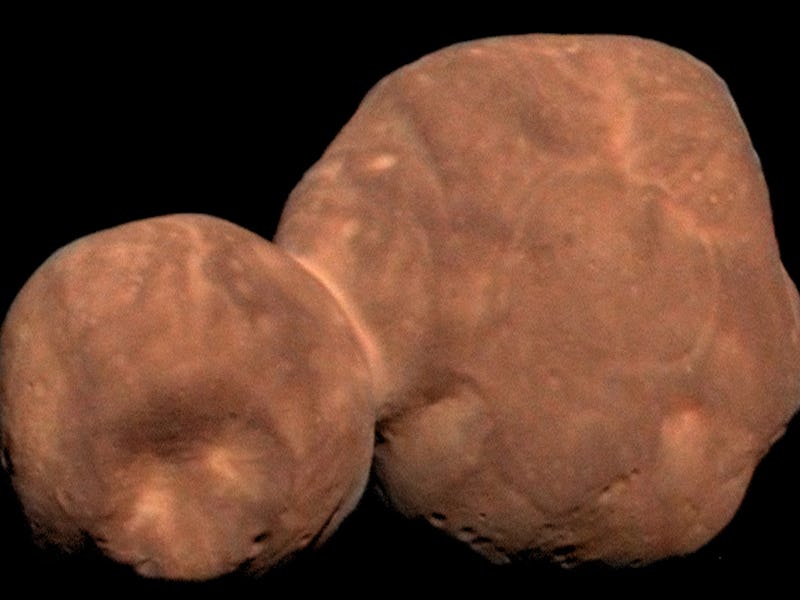This Dwarf Planet Is Basically A Sweet Red Snow Cone
Please do not lick the science.

If there were a recipe for Kuiper Belt’s sweetest dwarf planet, it would look something like this: Take one 22-mile long, figure-8-shaped blob of mixed ice, and add a heaping pour of methanol. Bombard with cosmic rays and solar wind for about 2 billion years, until it reaches a nice reddish color. Serve chilled to -390 degrees Fahrenheit.
A recent study found that Arrokoth, a weirdly-shaped dwarf planet in the Kuiper Belt, gets its distinctive reddish coloration from complex hydrocarbon molecules, which form when cosmic rays and solar wind bombard the tiny world’s frozen methanol surface. The same chemical reactions that spawn those hydrocarbons also produce sugars like glucose and glycerol, which means that if you licked Arrokoth, it would probably taste sweet, but also a little like soap. (Please don’t try this, because methanol is poison, and also you shouldn’t open your spacesuit helmet in a vacuum. Safety first!)
University of Hawai’i at Manoa chemist Chaojiang Zhang and colleagues published their work in the Proceedings of the National Academy of Science.
The chemical building blocks for life formed on Arrokoth thanks to chemical reactions in its ice, triggered by cosmic rays.
Lab-Grown Dwarf Planets
Zhang and colleagues froze a slab of methanol and carbon monoxide to around -390° Fahrenheit, or about 40 Kelvin, in their lab, then blasted it with high-energy electrons to simulate a couple billion years of cosmic rays.
The simulated cosmic rays triggered a series of chemical reactions in the ice, which produced complicated molecules called polycyclic aromatic hydrocarbons — the chemicals that stain Arrokoth’s surface a distinctive reddish color. Those same chemical reactions also produced sugars like glucose (the stuff that sweetens honey, berries, nuts, grains, and even potatoes), glycerol (the backbone of fatty acids called lipids, which make up part of our cell membranes, among other things), and ribose (and important part of DNA and RNA).
And the hydrocarbon molecules that give Arrokoth its color are built benzene, a chemical that is a ring of six carbon atoms with six hydrogen atoms on the outside. That ring structure is the basis for most organic chemistry, including some of the most important molecules for life: the “nucleobases” that make up the genetic code, as well as the amino acids that combine to form proteins.
In other words, the surface of Arrokoth is probably laden is with the chemical building blocks for life — and that’s pretty sweet, too.
“Sugar Worlds” Meet With Earth
Some of the ribose in your DNA right this moment may once have been locked in frozen ice on the surface of a world like Arrokoth.
“Sugar worlds” like Arrokoth may have played a role in giving Earth its starter kit of life-building molecules, like sugars and benzene-based hydrocarbon rings. Some of the comets that bombarded early Earth around 4 billion years ago may have come from tiny Kuiper Belt worlds like Arrokoth. And Zhang and colleagues’ experiment suggests those comets may have carried more than just water ice to our young planet.
Different Kuiper Belt worlds may have supplied different organic chemicals to early Earth, according to Zhang and colleagues. Pluto’s dancing partner, Charon, and another dwarf planet called Orcus, have water and ammonia frozen on their surfaces; others have carbon dioxide. Zhang and colleagues want to do more experiments in their lab to simulate how cosmic rays change the chemistry on each of those worlds to learn what’s out there — and how it got here.